Articles Menu
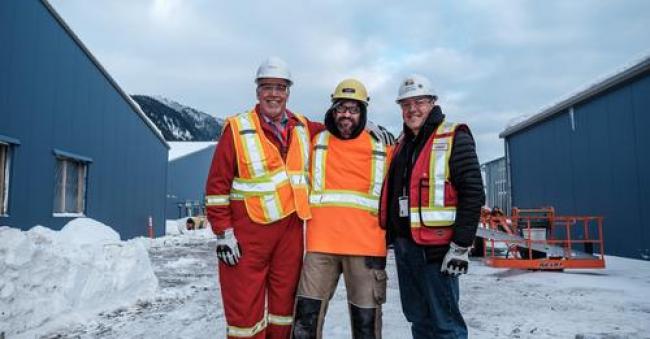
Aug 13, 2021
12 min. read
Under growing pressure to rein in greenhouse gas emissions, developers of liquefied natural gas (LNG) are turning to questionable claims about “carbon neutrality,” “net-zero,” or “green LNG,” in order to pass muster with governments, investors, and society, who are becoming increasingly anxious about the climate crisis.
However, while on the surface it may appear to be a positive shift towards lowering the greenhouse gas impact of their projects, the rhetoric about carbon-neutral LNG is mostly hollow, in another attempt to greenwash new fossil fuel projects into existence.
While the U.S. Gulf Coast typically receives much of the attention for the LNG rush, the Pacific Coast of Canada is home to multiple proposed LNG export projects, as energy companies scramble to export fracked gas from northeast British Columbia.
At least three proposed Canadian LNG projects are claiming they will be the cleanest LNG in the world, relying on renewable hydropower to power their liquefaction operations and otherwise using carbon offsets and carbon capture to partially mitigate their emissions. Left unsaid is that the offsets and captured carbon only account for a small portion of the total.
The assertions also lack detail, face technical problems, ignore leaking methane emissions, and depend on government subsidies for funding. The danger is that the net-zero claims obscure the true climate costs of LNG from the public, which experts warn can be on par or worse than coal, paving the way for the industry’s expansion. Claims that LNG can achieve “net-zero emissions” have been cited by both the B.C. and federal governments to justify greenlighting new gas export terminals.
Despite these claims, there is one LNG project under construction in B.C., and it alone could make the province’s climate targets almost impossible to meet. Additional LNG projects would likely cause the province to blow far past its targets. To complicate matters further, new research suggests that fugitive methane emissions from fracking operations are far higher than official data indicates.
“This idea that we are going to burn more fossil fuels to solve climate change is ridiculous,” Tracey Saxby, a marine scientist with My Sea to Sky, a B.C.-based grassroots organization opposing LNG, told DeSmog. “By investing in LNG now, we are going to be locking in climate pollution for 25 to 40 years.”
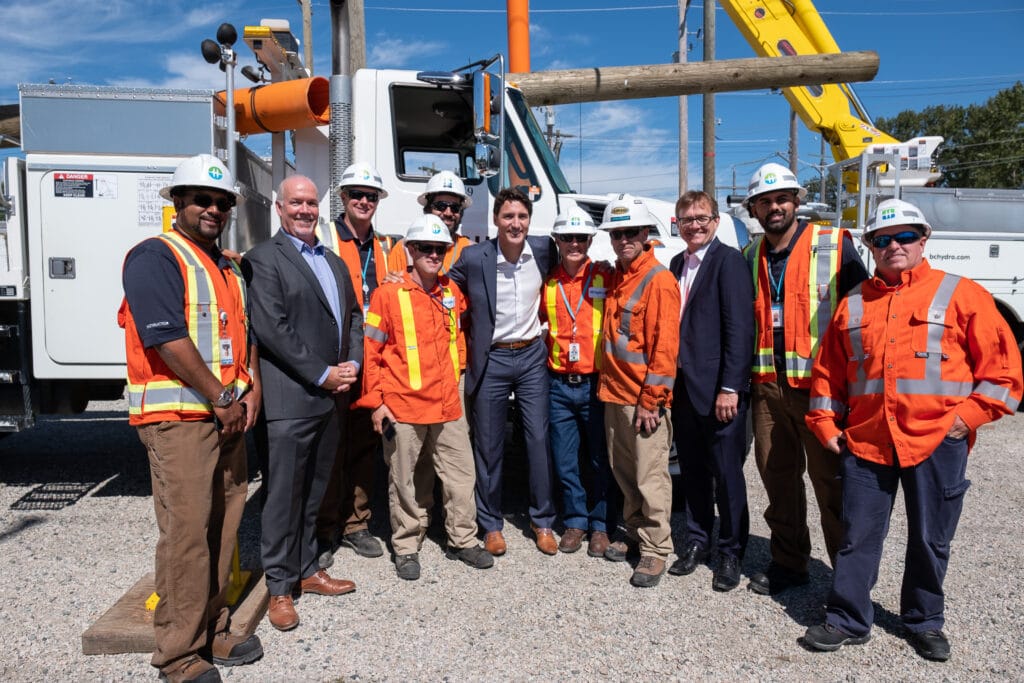 Canadian Prime Minister Justin Trudeau (middle) and B.C. Premier John Horgan (left) announce plans to use hydropower at B.C.’s LNG export terminals. August 29, 2019. Credit: Province of B.C. (CC BY-NC-ND 2.0)
Canadian Prime Minister Justin Trudeau (middle) and B.C. Premier John Horgan (left) announce plans to use hydropower at B.C.’s LNG export terminals. August 29, 2019. Credit: Province of B.C. (CC BY-NC-ND 2.0)
In July, the Nisga’a Nation, Rockies LNG, and Western LNG announced a new proposed $10 billion LNG project to be located in northern British Columbia near the border with southeastern Alaska. The project will ship “low carbon” gas from B.C. to Asia.
Western LNG is a Houston-based project developer, and Rockies LNG is a consortium of B.C.-based gas drillers that collectively produce a fifth of the province’s natural gas. They are partnering with the Nisga’a Nation on their territory.
The project, called Ksi Lisims LNG, comes as other LNG projects have been canceled due to high costs, delays, and weak global prices for LNG. Ksi Lisims argues that it will succeed where others failed because its “floating LNG” production vessel can reduce costs and the environmental footprint relative to onshore infrastructure. Global prices for LNG have also improved compared to years past, and partnering with First Nations may also reduce public opposition.
To obtain buy-in from the public and from the provincial and federal governments, Ksi Lisims makes lofty claims about its greenhouse gas impact.
“Fueled by clean British Columbia hydropower and supplied by low carbon Canadian natural gas, Ksi Lisims LNG will achieve one of the world’s lowest unit carbon emissions rates for a large-scale LNG export project, making net zero both feasible and achievable,” Western LNG CEO Davis Thames said in a statement. Thames is a former executive at Cheniere Energy, a prominent U.S. LNG company, and before that, a director at Enron.
Looking closer, however, the project developers say it will use carbon offsets and “potential” carbon capture and storage, to achieve its goals. It also says it will aim for net-zero “within 3 years of start up,” rather than at the outset, leaving quite a bit of wiggle room. No further information is given on the specific details of these plans.
Ksi Lisims LNG is not the only such project in B.C. making similar claims. Woodfibre LNG, a proposed project in Squamish, just north of Vancouver, says it will be the “cleanest LNG facility in the world.” Pembina’s proposed Cedar LNG project makes similar assertions.
In comparison, LNG Canada, the only project currently under construction in all of Canada, states that its emissions will be “less than half” of the average LNG facility because it will use efficient gas turbines.
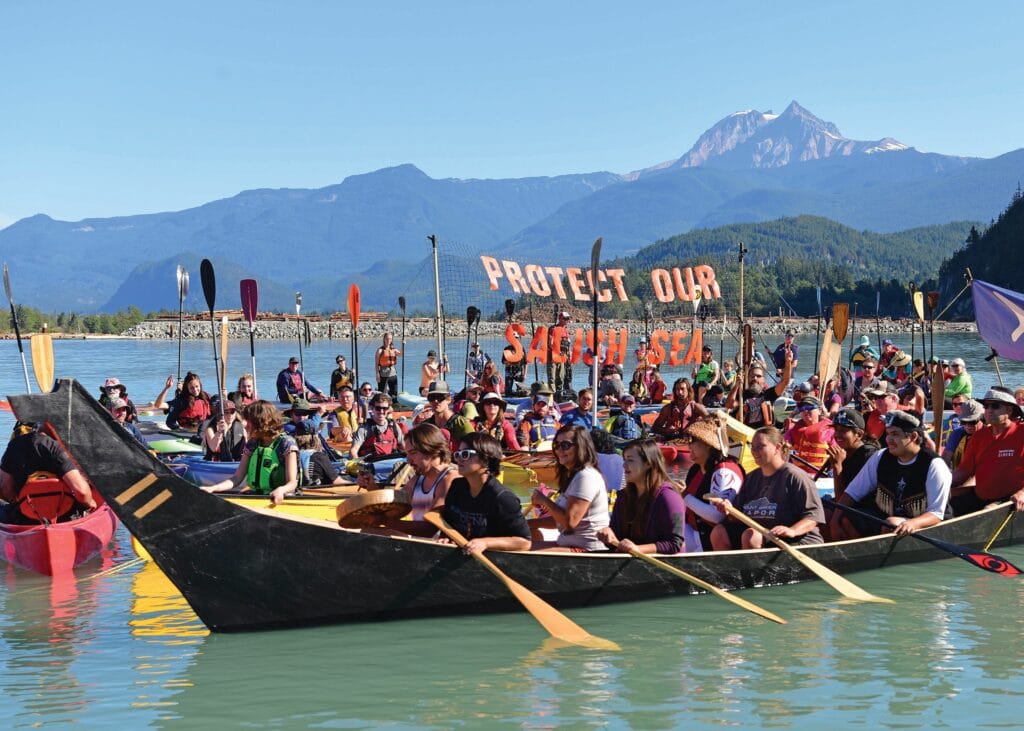
But at a time when scientists continue to reiterate that the world needs to rapidly ratchet down emissions, the expansion of LNG in Canada is a major setback.
As reported by The Narwhal, the Shell-backed LNG Canada project alone would mean B.C.’s climate targets become exceedingly difficult to achieve. This single LNG project will produce the equivalent annual CO2 emissions of 2.8 million cars, and it is aiming to remain operational for 40 years, well into the second half of the century.
“[L]ocked-in emissions from LNG Canada alone will make it extremely difficult, if not impossible, for BC to meet its 2040 and 2050 targets of 60% and 80% emission reductions (below 2007 levels),” Marc Lee, a senior economist at the Canadian Centre for Policy Alternatives, wrote in January 2021.
And that is from just one project. Each additional LNG project would result in ballooning emissions for which the province has not accounted.
“Their models don’t include any of the other [LNG projects] at this point. Just Phase 1 of LNG Canada,” Andrew Gage, a staff lawyer with West Coast Environmental Law, told DeSmog, referring to B.C.’s climate goals. “We are deeply skeptical that the climate goals can be achieved while still having an expansion of LNG.”
A spokesperson from the B.C. Ministry of Energy, Mines and Low Carbon Innovation told DeSmog that any additional LNG project must fit within the province’s climate targets. The spokesperson also pointed to emissions targets for the industrial sector, including for drilling. “Emission reductions will be achieved through key mitigation measures including electrification in the upstream and regulations that require oil and gas sector methane emission reductions to be reduced by 45 percent below 2014 levels by 2025,” the spokesperson stated.
But much of the goals rest on the vague promises of carbon capture technologies. In October 2020, B.C. Premier John Horgan made a campaign stop at Carbon Engineering, a Squamish-based carbon capture firm. He highlighted their technologies as a way of framing his push for net-zero emissions for the province by 2050.
When DeSmog inquired with Carbon Engineering about whether achieving “net-zero LNG” was even technically possible, a spokesperson declined to comment.
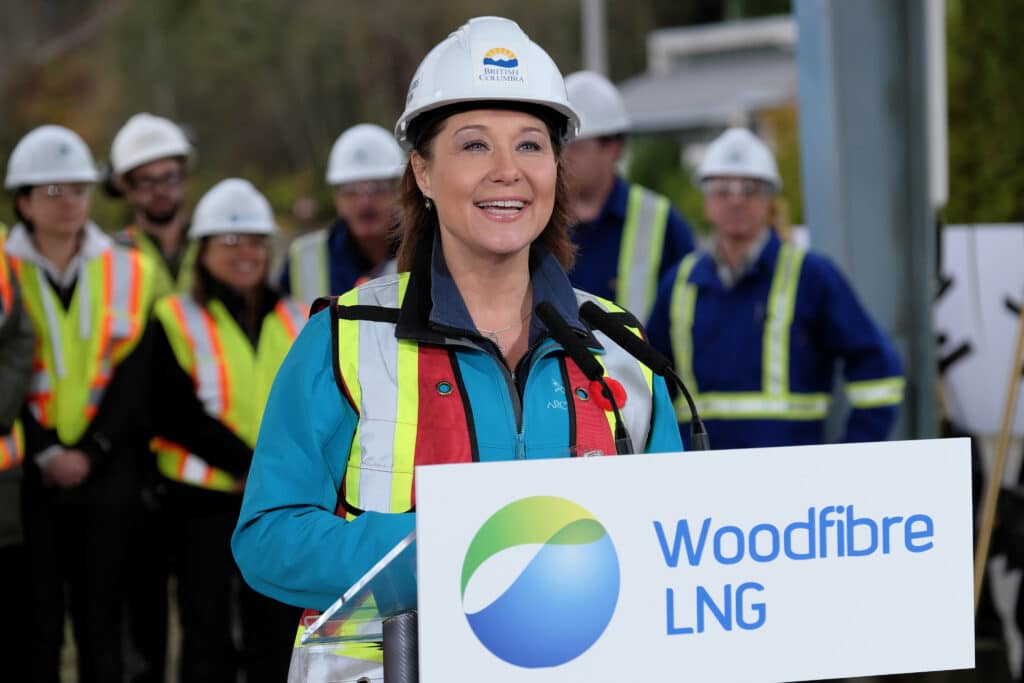
The promotion of “clean” or “low-carbon” LNG in British Columbia is part of a global trend within the oil and gas industry, with companies trotting out new claims of pursuing “net-zero” emissions by mid-century. The net-zero plans conspicuously do not include winding down drilling operations, but instead hinge on deploying carbon capture and sequestration technologies and carbon offsets.
DeSmog has previously reported on how carbon capture is costly and has an erratic track record riddled with technical and market challenges, and how bullish industry claims about the future of carbon capture are dependent on government subsidies.
While this dynamic applies to the fossil fuel industry as a whole, developers of proposed LNG export terminals have enthusiastically turned to carbon capture to promote “net-zero” LNG. The PR strategy has taken on several related forms.
First, they use offsets. Cheniere Energy, for example, claimed earlier this year that it shipped its first “carbon-neutral” LNG cargo to Shell, offsetting the greenhouse gases emitted during the transportation of the gas via Shell’s “global portfolio of nature-based projects.” The companies did not offer additional detail.
In July, BP said that it was delivering a “carbon-neutral” LNG cargo to a terminal owned by Sempra LNG in Baja, Mexico. DeSmog inquired about the details of the offsets, but Sempra’s subsidiary, IEnova, did not respond.
There are many problems with offsets. The specific offset projects are typically hidden from public view, lack standardized carbon accounting, and even if authentic, often offset only a portion of a project’s climate impact. Nature-based offsets — such as reforestation — also raise troubling questions about land use, as offset projects compete with agriculture or other development and potentially force Indigenous people off their traditional lands. And if wildfires hit a patch of forest designated as an offset, for example, much of the carbon ends up emitted anyway.
A recent investigation by Bloomberg Green found even more glaring problems with LNG-related carbon offsets. French oil giant TotalEnergies scrambled to put together its first “carbon-neutral” LNG cargo last year, with junior traders “essentially winging it,” which involved “googling and guesswork.” The company landed on a carbon offset project in Zimbabwe, which amounted to paying a volunteer to clear brush to avoid wildfire.
In this way, Total claimed that its LNG cargo shipped to China, which carried life-cycle emissions equivalent to what 30,000 U.S. households produce in a year, was fully offset. Bloomberg says the offset did “virtually nothing to decrease carbon dioxide,” and that the broader world of carbon-neutral LNG “doesn’t exist.”
The second main strategy LNG developers deploy to position their projects as climate-friendly is to promise to use carbon capture and sequestration (CCS). For example, a company called Venture Global LNG announced in May 2021 that it would implement CCS at its Calcasieu Pass project in Louisiana.
But even if developers were to successfully pull it off – a big “if” – it would only account for the liquefaction stage, the process of turning natural gas into LNG, a small slice of the project’s total greenhouse gas emissions.
A 2019 study from the U.S. Department of Energy found that the liquefaction process only accounted for roughly 6 to 7 percent of the emissions life-cycle of LNG. The majority of emissions occur when the power plant on the other side of the world burns the gas. But a significant portion also occurs upstream during the drilling process and when the gas is shipped in pipelines and on tankers.
Methane, an extremely powerful greenhouse gas, for instance, leaks up and down the supply chain – at the wellhead, in storage tanks, pipelines, compressor stations, export terminals, LNG tankers, and regasification terminals.
The technical challenges are also not trivial. Chevron operates what it has described as “the world’s largest commercial-scale carbon dioxide injection project” in the world at its Gorgon LNG plant in Australia. Chevron was supposed to capture 80 percent of the emissions from the facility in the first five years of the project’s lifespan, but the company recently announced that amid technical challenges and cost overruns, it failed to meet that target. The company may only capture 30 percent of the emissions, and faces potential fines in Australia as a result.
“LNG CCS has proven more of a talking point and less of a reality,” Global Energy Monitor said in a July report investigating the growing trend of the incorporation of CCS in LNG projects.

The technical challenges with carbon offsets and CCS are compounded by the fact that the technologies are very expensive. As a result, the companies are turning to the government for help.
LNG projects in B.C. already enjoy hundreds of millions of dollars in subsidized electricity, subsidies for energy-efficient gas turbines, and other tax credits.
A recent analysis by environmental organization Stand.earth found that the B.C. government spent more on fossil fuel subsidies (C$1.3 billion, or USD$1 billion) than it did on climate change programs (C$1.1 billion, or USD$0.9 billion). Nearly one-third of that money went to incentives for upstream fracking.
One estimate puts the provincial subsidies for LNG Canada alone at over C$5 billion (USD$4 billion).
But the province may end up forking over even more money to the industry in an effort to cut emissions.
In July, B.C. and the federal government announced that it was establishing a new “Centre for Innovation and Clean Energy” in partnership with Shell Canada. Each entity will start off with a C$35 million (USD$28 million) investment to innovate new technologies, with a focus on developing CCS.
Lobbying records show that on May 3, Woodfibre LNG lobbied Fazil Mihlar, Deputy Minister at B.C.’s Ministry of Energy, Mines and Low Carbon Innovation, and they discussed the “competitiveness gap” in the province’s LNG framework, and what “fiscal instruments” might be available to Woodfibre LNG.
Tracey Saxby of My Sea to Sky, who has closely tracked the proposed Woodfibre LNG project, says the meeting was almost certainly an example of the company seeking subsidies.
“These projects are already receiving a huge amount in subsidies and tax breaks and incentives from the provincial government. But now they are going to have their hand out for even more money because they’re looking to pursue net-zero,” Saxby said. “This is LNG’s latest Big Lie.”
When asked about the nature of the meeting, Deputy Minister Mihlar said it was a “general update” on the Woodfibre LNG project.
“The project is in the pre-FID stage, and while we aspire to net-zero, we’re not yet in a position to lay out a pathway to that specific goal,” Rebecca Scott, a spokesperson for Woodfibre LNG, said in a statement to DeSmog. Pre-FID refers to a stage prior to a final investment decision, before the project officially receives a green light. When asked about the lobbying meeting between Woodfibre and Deputy Minister Mihlar, Scott said that Woodfibre was unable to provide more details on such short notice.
Doug Ford, a spokesperson for Ksi Lisims LNG, said that its project “aims to achieve net zero GHG [greenhouse gas] emissions from the LNG liquefaction facility through rigorous GHG management and connecting the facility to clean hydroelectricity.”
Ford added: “Greenhouse gas emissions that cannot be eliminated from the liquefaction plant will be offset and/or potentially captured and sequestered.”
When asked about the full life-cycle of emissions when making claims about net-zero, Ford said “Ksi Lisims LNG is focused on achieving net zero on a lifecycle basis from the liquefaction plant,” adding: “In the future, we will track the full supply chain emissions and offsets of LNG exports from the project for our customers’ purposes.”
When asked if Ksi Lisims would need subsidies to implement carbon capture technologies, Ford said: “We are looking at options for carbon capture on the project. We’ll continue to watch how the sector and policy evolves.”
LNG Canada did not respond to a request for comment.
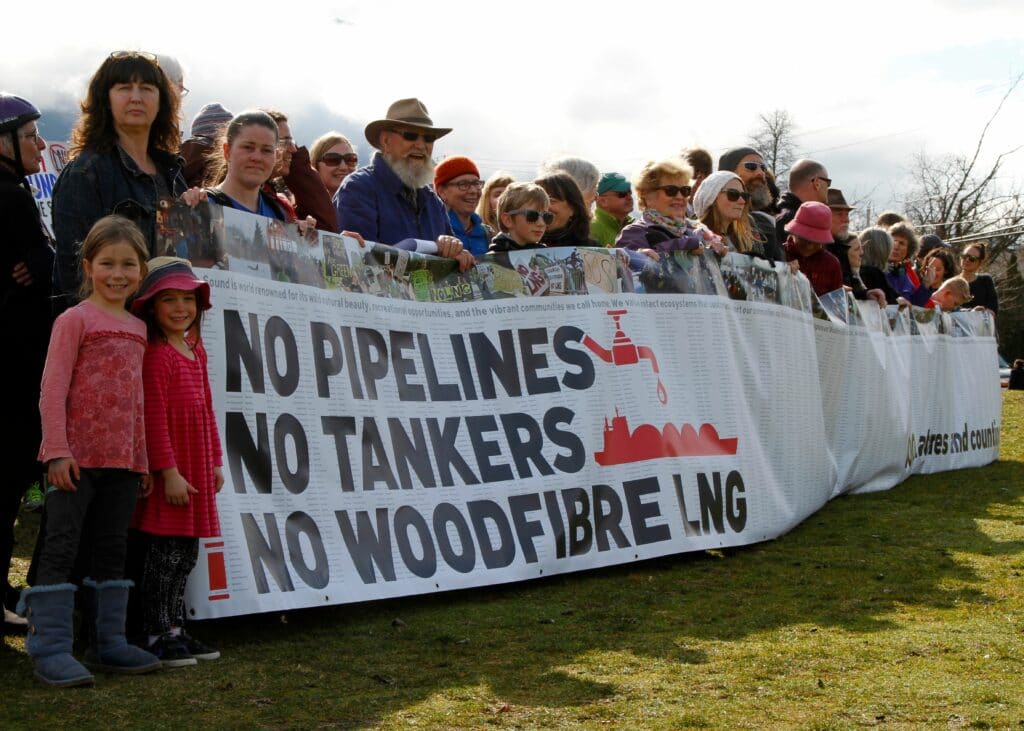
While industry and the province try to figure out carbon capture technologies, which would be used at the liquefaction sites, they have largely ignored the enormous climate problem at upstream fracking operations, including leaking methane.
A report from Capterio, a private firm that works with the oil and gas industry to cut flaring, finds that high levels of flaring in the worst cases can increase the CO2-equivalent emissions of an LNG project by 50 percent. Many LNG projects source their gas from less flaring-intensive sites, but that estimate does not include leaking methane.
And that’s another place where the “clean” claims from LNG projects in B.C. fall apart. A July study in Environmental Science & Technology finds that methane emissions from fracking operations in British Columbia could be as much as 1.6 to 2.2 times higher than Canadian government data suggests.
The researchers from Carleton University combined data from aerial surveys and optical gas imaging cameras, and found that leaking methane was a much worse problem than is commonly thought. Notably, the methane leaks occurred not just from one particular source, but across multiple stages – from oil storage tanks, pneumatic devices, compressor stations, and unlit flares.
The Permian basin in Texas has earned an infamous reputation for methane leaks, but the B.C. study shows that leaking methane is a serious climate problem elsewhere. DeSmog previously reported on the massive methane leaks at oil and gas infrastructure in Europe, adding more evidence that methane is a global, industry-wide problem.
The possibility that B.C. fracking operations are leaking methane at roughly double the levels that the government estimates severely undercuts the claims of being a climate solution, let alone carbon-neutrality.
In its most recent landmark report released this month, the Intergovernmental Panel on Climate Change (IPCC) singled out methane as an urgent and immediate area of focus for the world’s climate efforts.
Canada’s gas industry recently received a warning sign from the other side of the country. In July, the province of Quebec rejected the proposed $14 billion GNL Quebec project at the Port of Saguenay. The project would have piped in fracked gas from British Columbia, liquefied it, and exported it abroad from Quebec.
Notably, GNL Quebec also said that it would be a carbon neutral facility via offsets. After stiff resistance from the public, the provincial Environment Minister Benoit Charette rejected the project, citing concerns that LNG would hook buyers overseas on gas and delay the energy transition. “This is a project that has more disadvantages than advantages,” he said.
Environmental groups argued the same logic should apply to Canada’s other LNG projects. “The Government of Quebec showed true leadership today by rejecting a new fracked gas export project,” Julia Levin, senior climate and energy program manager at Environmental Defence, said in a statement. “There are at least 20 other fossil fuel projects under consideration for approval across Canada. All levels of governments in Canada should follow Quebec’s lead and reject these projects.”
[Top photo: Premier John Horgan (left) visits LNG Canada to assess its progress. Credit: Province of B.C. (CC BY-NC-ND 2.0)]